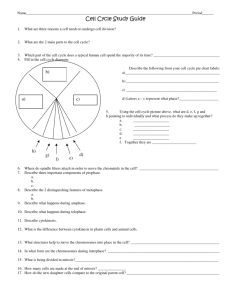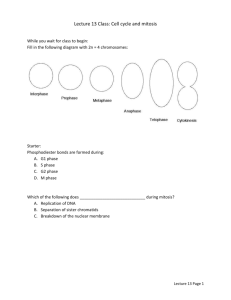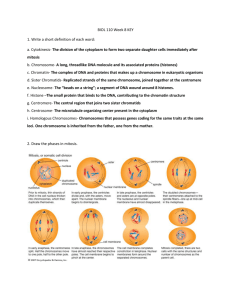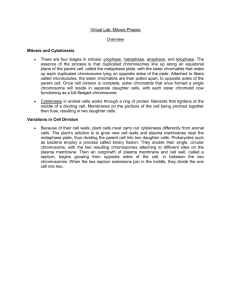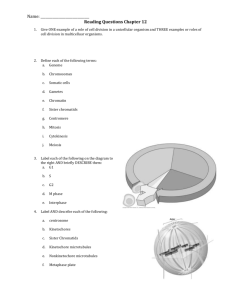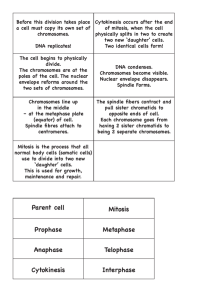meiosis ii
advertisement
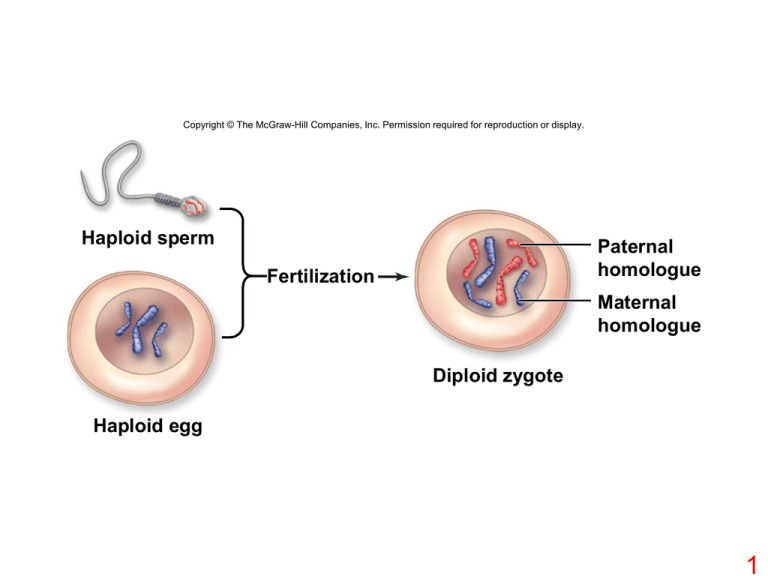
Copyright © The McGraw-Hill Companies, Inc. Permission required for reproduction or display. Haploid sperm Paternal homologue Fertilization Maternal homologue Diploid zygote Haploid egg 1 Copyright © The McGraw-Hill Companies, Inc. Permission required for reproduction or display. Sperm (haploid) n Egg (haploid) n n 2n Zygote (diploid) 2n MITOSIS Somatic cells Germ-line cells Germ-line cells MITOSIS Adult male (diploid) 2n Adult female (diploid) 2n 2 Copyright © The McGraw-Hill Companies, Inc. Permission required for reproduction or display. Kinetochore Diploid cell Sister chromatids Synaptonemal complex Chromosome duplication Homologues Centromere a. Synaptonemal complex Homologous chromosomes Meiosis I Meiosis II Haploid cells b. 138 nm c. b: Reprinted, with permission, from the Annual Review of Genetics, Volume 6 © 1972 by Annual Reviews, www.annualreviews.org 3 Copyright © The McGraw-Hill Companies, Inc. Permission required for reproduction or display. Site of crossover 4 Copyright © The McGraw-Hill Companies, Inc. Permission required for reproduction or display. Mitosis Meiosis I Metaphase I Chiasmata hold homologues together. The kinetochores of sister chromatids fuse and function as one. Microtubules can attach to only one side of each centromere. Anaphase I Metaphase Homologues do not pair; kinetochores of sister chromatids remain separate; microtubules attach to both kinetochores on opposite sides of the centromere. Anaphase Microtubules pull the homologous chromosomes apart, but sister chromatids are held together. Microtubules pull sister chromatids apart. 5 Copyright © The McGraw-Hill Companies, Inc. Permission required for reproduction or display. 6 Copyright © The McGraw-Hill Companies, Inc. Permission required for reproduction or display. MEIOSIS I Prophase I Metaphase I 40 µm Chromosome (replicated) Spindle Telophase I Anaphase I 40 µm Kinetochore microtubule 40 µm Sister chromatids Sister chromatids Paired homologous Chiasmata chromosomes Nonidentical sister chromatids Chromosome Homologue pair on metaphase plate Homologous chromosomes In prophase I of meiosis I, the chromosomes begin to condense, and the spindle of microtubules begins to form. The DN A has been replicated, and each chromosome consists of two sister chromatids attached at the centromere. In the cell illustrated here, there are four chromosomes, or two pairs of homologues. Homologous chromosomes pair up and become closely associated during synapsis. Crossing over occurs, forming chiasmata, which hold homologous chromosomes together. 40 µm In metaphase I, the pairs of homologous chromosomes align along the metaphase plate. Chiasmata help keep the pairs together and produce tension when microtubules from opposite poles attach to sister kinetochores of each homologue. A kinetochore microtubule from one pole of the cell attaches to one homologue of a chromosome, while a kinetochore microtubule from the other cell pole attaches to the other homologue of a pair. In anaphase I, kinetochore microtubules shorten, and homologous pairs are pulled apart. One duplicated homologue goes to one pole of the cell, while the other duplicated homologue goes to the other pole. Sister chromatids do not separate.This is in contrast to mitosis, where duplicated homologues line up individually on the metaphase plate, kinetochore microtubules from opposite poles of the cell attach to opposite sides of one homologue's centromere, and sister chromatids are pulled apart in anaphase. © Clare A. Hasenkampf/Biological Photo Service Homologous chromosomes In telophase I, the separated homologues form a cluster at each pole of the cell, and the nuclear envelope re-forms around each daughter cell nucleus. Cytokinesis may occur . The resulting two cells have half the number of chromosomes as the original cell: In this example, each nucleus contains two chromosomes (versus four in the original cell). Each chromosome is still in the duplicated state and consists of two sister chromatids, but sister chromatids are not identical because crossing over has occurred. 7 Copyright © The McGraw-Hill Companies, Inc. Permission required for reproduction or display. MEIOSIS II Prophase II Metaphase II 40 µm Spindle Nuclear membrane breaking down Following a typically brief interphase, with no S phase, meiosis II begins. During prophase II, a new spindle apparatus forms in each cell, and the nuclear envelope breaks down. In some species the nuclear envelope does not re-form in telophase I removing the need for nuclear envelope breakdown. Telophase II Anaphase II 40 µm Sister chromatids Chromosome In metaphase II, a completed spindle apparatus is in place in each cell. Chromosomes consisting of sister chromatids joined at the centromere align along the metaphase plate in each cell. No w , kinetochore microtubules from opposite poles attach to kinetochores of sister chromatids. 40 µm 40 µm Nuclear membrane re-forming Kinetochore microtubule Sister chromatids When microtubules shorten in anaphase II, the centromeres split, and sister chromatids are pulled to opposite poles of the cells. © Clare A. Hasenkampf/Biological Photo Service In telophase II, the nuclear membranes re-form around four di f ferent clusters of chromosomes. After cytokinesis, four haploid cells result. No two cells are alike due to the random alignment of homologous pairs at metaphase I and crossing over during prophase I. 8 Copyright © The McGraw-Hill Companies, Inc. Permission required for reproduction or display. MEIOSIS I Prophase I Metaphase I Anaphase I Telophase I Parent cell (2n) Chromosome Paternal replication homologue Homologous chromosomes pair; synapsis and crossing over occur. Paired homologous chromosomes align on metaphase plate. Homologous chromosomes separate; sister chromatids remain together. MITOSIS Prophase Metaphase Anaphase Telophase Chromosome Homologous replication chromosomes Maternal homologue Two daughter cells (each 2n) Homologous chromosomes do not pair. Individual homologues align on metaphase plate. Sister chromatids separate, cytokinesis occurs, and two cellsresult, each containing theoriginal number of homologues. 9 Copyright © The McGraw-Hill Companies, Inc. Permission required for reproduction or display. MEIOSIS II Prophase II Metaphase II Anaphase II Telophase II Four daughter cells (each n) Chromosomes align, sister chromatids separate, and four haploid cells result, each containing half the original number of homologues. 10


